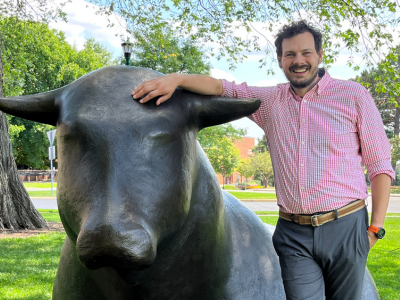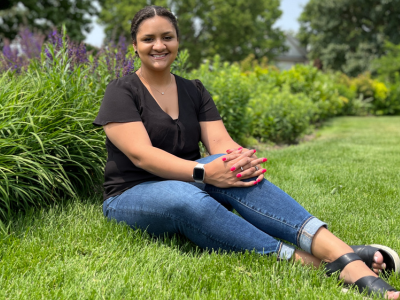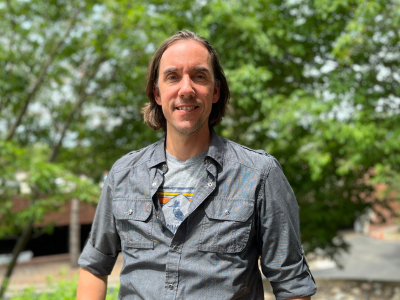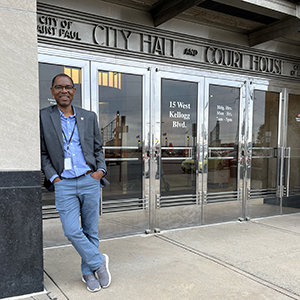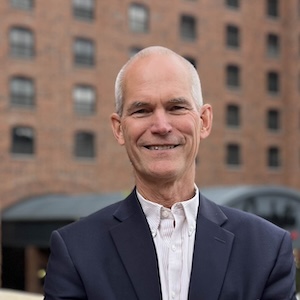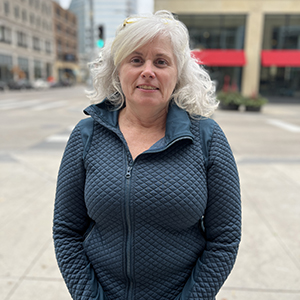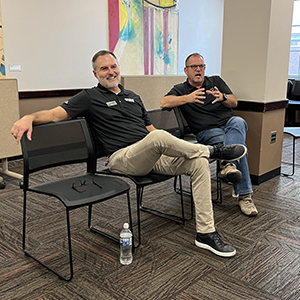Three Construction Management instructors who were once students in the program share advice and lessons learned
Photo: CMGT instructors Ben Bowman, Aalayha Traub, and Jeremiah Cunningham
CMGT graduates Ben Bowman, Aalayha Traub, and Jeremiah Cunningham have not only excelled in their respective careers, they have returned to the U to share their expertise with aspiring leaders in the construction management program at the College of Continuing and Professional Studies. We caught up with them to find out what they’ve learned since returning to teach their craft, why they teach on top of already busy lives, and what advice they have for students.
Ben Bowman
Ben earned his bachelor’s degree in construction management in 2014. He already had a degree in painting and art history, but a stint managing a coffee shop made him realize he had a head for management and business. After graduating, he went to work for Adolfson & Peterson (AP) Construction, where he had completed an internship the previous summer, starting as a field engineer and rising to senior project manager. (Read more about Ben’s journey from artist to construction manager in Coming Full Circle).
In his role at AP, Ben has led remodeling and new construction projects and has overseen all aspects of the process, including estimating, bidding, and project management. Since starting at AP, he also completed an MBA from the University of Nebraska-Lincoln.
“In my day job, I’m not an estimator, per se,” says Ben, who started teaching the Construction Estimating course in fall 2019, after shadowing the outgoing instructor for a semester. “However, everything I do has a dollar sign in front of it. I manage costs, manage budgets, manage production. It all factors into the cost of construction. So that’s how my day job relates to my night job.”
Have you had any revelations about teaching since you began five years ago?
I find myself less worried about individual assignments. I recognize that these students are almost all working adults. If they miss a class or are late handing in an assignment, so be it. Because really, the big picture is: Are they getting something out of it? Are they learning the important takeaways?
I recognize that many students may already be working in construction, they may come to class wearing a little dust on their shoulder. We try to meet students where they are.
What’s the most valuable thing about the Construction Management program?
All the faculty are working in the construction industry. We’re not academics who live in a world of theory. We are teaching our craft, our practice, to our students. We’re sharing examples of what we do everyday at work.
For example, in a recent class we were talking about what types of things go into what we’re charging a client. They want to know when they’re being charged $95 an hour for labor, what goes into that number. There’s a whole slew of things, of course, and I was able to pull up a spreadsheet that I received that very morning and say, “Well, look. Here’s our real-life example of an owner asking for this breakdown and this is what we gave them.”
Aalayha Traub
After graduating with a double major in architecture and construction management in 2020, Aalayha went to work as a virtual design in construction specialist for Knutson Construction, using computer software to create digital versions of a project before it’s developed in the physical world. “It was a really good opportunity to bridge the gap between those two skill sets—design and construction—which was exactly what I was looking for,” she says. (Read more about Aalayha’s path from double major to niche software specialist in The Grit to Succeed in Construction).
Within two years she was managing the unit, yet still felt she could be doing more. “I’m very, very blessed to love my job. But I’m always looking for outside things to fulfill myself, things that speak to my purpose,” says Aalayha. She sought the advice of Peter Hilger, the program’s faculty director, who asked her if she’d ever thought about teaching.
Although the idea initially intimidated her, being so fresh out of school herself, she dove in headfirst and started teaching Managing with Building Information Modeling in the fall of 2022.
What’s your motivation to teach?
What’s really driving me is, for the few women I have in my class, I bet it’s nice to have a woman that’s doing something that you’re going into. They see so many men in construction and it gets very redundant. I show them that anybody who looks like anything can make it.
The nice thing is, of course, I do all this for my job, using Revit, Autocad, looking at point clouds, things like that. And I’ve been starting to use more examples from my work, like, “This is what I’m going to teach you, but this is how you might actually apply it.”
Are you developing a teaching philosophy?
Yes. It’s less about getting students prepared to work in the field and more about understanding the tools so that, when they are working in the industry, they will know what kind of tool and expertise they need to get a particular job done. It’s not realistic for everyone to be an expert.
Also, I wanted the students to get some different perspectives from mine so, in the last week of class, I switched it up and had a few people who work with me come in and talk to the students—again, to expose them to different people and roles and skill sets. A lot of students had good feedback on that bit.
Jeremiah Cunningham
Jeremiah started his career in construction a little later in life than traditional college-age students. He had already completed a degree and had gone back to school to become a teacher. That is, until he started to consider the time it would take, and he was anxious to start a family. “I was already in my 30s and another five to eight years of school felt like a long time. So I looked into the construction management program.” (Read about how Jeremiah’s CMGT internship is helping improve pollinator habitat in Butterfly Effect).
In 2015, a year before graduating, thanks to previous experience working in his family’s construction business, Jeremiah was hired by The Opus Group, which he met at a career fair where he was practicing his elevator speech. His title is project manager, but he says his job covers a lot more than that.
“There are many professions at The Opus Group under one umbrella. I fall under the construction umbrella. I manage the design teams and the construction teams, from a napkin sketch to buyout, construction of the building, and turn over to whomever the owner is,” says Jeremiah, who is also working on completing an MBA.
Happily, Jeremiah not only found a fulfilling career in construction, he also realized his dream of becoming a teacher when he began instructing the Construction Plan Reading course at CCAPS in fall 2022.
What do you want students to learn in your class, beyond how to read plans?
Honestly, I try to talk to them about their careers as much as possible ...what that career might look like, answering related questions, and letting them know where they can seek career opportunities, like career fairs.
Also, being able to present and give a good elevator speech is crucial. There’s your capstone project and your internship project, where you’ll typically be presenting at your internship company. So dressing up and being a good communicator is important.
Should students focus on anything in particular in their career search?
You know, these students work so hard to get through this program but just don’t seem to know what a good resume looks like. I know because I read a lot of them at my job. I actually have spent 15 to 20 minutes in class just talking through resume prep.
When I started my job search, I talked to Liz Hruska in Career and Internship Services. We met, like, three times just to flesh out my resume and sharpen my elevator pitch. That’s the elevator pitch and the resume I used to get this job.

